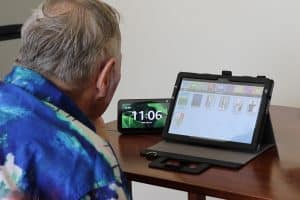Alexa, Call My SLP: Using Smart Tech to Boost AAC.
Felicia Williamson
Felicia Williamson
Key Takeaways:
Summary:

Client using a TouchTalk device with an Amazon Alexa
Smart home assistants, such as Amazon Echo and Google Home, are becoming common parts of many households. This presents a unique opportunity for AAC users to use these voice-operated systems by programming commands into their device. By combining the powers of AAC with smart home assistants, AAC users are likely to experience benefits in four areas:
Although it can feel intimidating to combine the technology, it’s easy to start small. Identify a couple of meaningful voice commands and create a dedicated page to make the connection easy.
Incorporating the Research into Clinical Practice with Lingraphica
Lingraphica AAC devices are ready to communicate with a smart home assistant right away. They even come with a pre-programmed smart home assistant page with some of the most common voice commands – you can find it in the icon library under technology.
When using a Lingraphica AAC device with a patient, ask if they use a smart home assistant. If so, identify some of the things that are important to them – not only will this help you customize the device, but you can also think of ways to incorporate the smart home speaker to increase motivation and independence. This could be something simple like hearing the day’s weather report or checking a favorite team’s score.
If your patient seems hesitant to use a device to communicate with others, using a device to communicate with a smart home assistant can be a great way to “break the ice.” Using the device to interact with a smart home speaker removes some of the pressure and any embarrassment your patient might feel at using a device with friends and family. Communicating with a smart home assistant can help build the skills, confidence and comfort that the user needs to begin communicating in other contexts.

We help adults with speech and language impairments to reconnect with family and friends, improve communication, and live their best lives. Call us at 866-570-8775 or visit the link below to get started.

